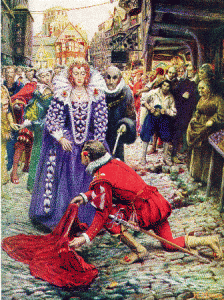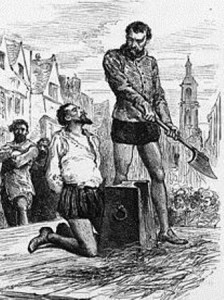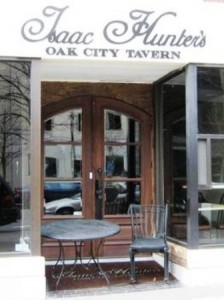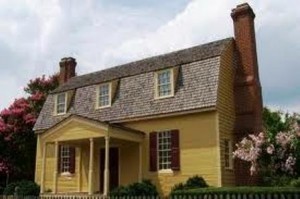» posted on Wednesday, February 27th, 2013 by Linda Lou Burton
From Axe To Acts
 Linda Burton posting from Raleigh, North Carolina – I don’t know about you, but I have always associated Sir Walter Raleigh (1552-1618) with chivalry. He’s the guy who threw down his cape so Queen Elizabeth wouldn’t have to step in a puddle, or so I’d heard. Since I’m in the city that was named for him, I’ve been reading up on the English gentleman, and asking questions of Raleigh residents. But it’s been like those Jimmy Kimmel street interviews; I didn’t find a soul who was aware that poor Walter fell out of favor with the royals and was (ouch) beheaded. As was the custom in those days of yore, his embalmed head was delivered to his wife. His body was buried in London in the chancel of St Margaret’s, abutting Westminster; you can visit his tomb today. So was he a chivalrous fellow? Probably so; his resume is an exciting read – aristocrat, courtier, poet, writer, adventurer, explorer, spy. We know he went to Oriel College in Oxford; we know he fought for England in Ireland, helping to put down the Desmond Rebellions. He was a dashing figure
Linda Burton posting from Raleigh, North Carolina – I don’t know about you, but I have always associated Sir Walter Raleigh (1552-1618) with chivalry. He’s the guy who threw down his cape so Queen Elizabeth wouldn’t have to step in a puddle, or so I’d heard. Since I’m in the city that was named for him, I’ve been reading up on the English gentleman, and asking questions of Raleigh residents. But it’s been like those Jimmy Kimmel street interviews; I didn’t find a soul who was aware that poor Walter fell out of favor with the royals and was (ouch) beheaded. As was the custom in those days of yore, his embalmed head was delivered to his wife. His body was buried in London in the chancel of St Margaret’s, abutting Westminster; you can visit his tomb today. So was he a chivalrous fellow? Probably so; his resume is an exciting read – aristocrat, courtier, poet, writer, adventurer, explorer, spy. We know he went to Oriel College in Oxford; we know he fought for England in Ireland, helping to put down the Desmond Rebellions. He was a dashing figure  of 29 when he (supposedly) assisted the Queen with a sweep of his cape; he was granted 40,000 acres of land in Munster not too long after that; he sat in Parliament; he was a favorite in the Queen’s court. Did he ever come to North America? He did not. So what did he do to get himself beheaded, and why was Raleigh, North Carolina named for him some 174 years after his death?
of 29 when he (supposedly) assisted the Queen with a sweep of his cape; he was granted 40,000 acres of land in Munster not too long after that; he sat in Parliament; he was a favorite in the Queen’s court. Did he ever come to North America? He did not. So what did he do to get himself beheaded, and why was Raleigh, North Carolina named for him some 174 years after his death?
Raleigh’s connection to North Carolina is simple: On March 25, 1584, Queen Elizabeth granted him a charter to establish a colony in North America. That is a fascinating story unto itself; he sent a reconnaissance crew first; native Croatans Manteo and Wanchese were  brought back to England and from them Raleigh gained a better understanding of the geography and politics of the area that is now Roanoke, North Carolina. The Queen was impressed; Raleigh was knighted in 1585 as a reward. In 1587 he sent a party of 100 soldiers, miners and scientists, and later a group of 117 men, women and children. Supply ships supporting the colony were delayed in returning until 1581, when they found no one living; only the letters CRO carved into a tree. The 117 pioneers had vanished; the settlement is referred to today as The Lost Colony of Roanoke.
brought back to England and from them Raleigh gained a better understanding of the geography and politics of the area that is now Roanoke, North Carolina. The Queen was impressed; Raleigh was knighted in 1585 as a reward. In 1587 he sent a party of 100 soldiers, miners and scientists, and later a group of 117 men, women and children. Supply ships supporting the colony were delayed in returning until 1581, when they found no one living; only the letters CRO carved into a tree. The 117 pioneers had vanished; the settlement is referred to today as The Lost Colony of Roanoke.
In 1592, Sir Walter got married. Unfortunately, he married one of the Queen’s Maids-In-Waiting without asking permission. The Queen sent him, and his wife Bess, to the Tower! Was the Virgin Queen jealous? Or just angry that she hadn’t been consulted? His life was a series of ups and down after that; he stayed married and had sons Walter and Carew over the years. He was released from prison, sailed on a voyage of conquest to South America, wrote a tale of adventure, led a naval expedition, and then, in 1603, Queen Elizabeth died. Sir Walter was allegedly part of the plot against the appointment of James as king; James I had Raleigh arrested and tried for treason. Prison time was a good time for writing; he wrote Historie of the World in the long years he was there. Released and sent once again on a voyage to South America in search of riches and gold, he made an unauthorized attack on a Spanish outpost;  son Walter was killed in the fight. When Raleigh returned to England King James had him imprisoned once again, and this time, executed. He is reputed to have said to his executioner, when shown the axe, “Strike man, strike! My ague is upon me and I do not want my enemies thinking I died quaking in fear.” This poem was found in his cell in the Tower of London:
son Walter was killed in the fight. When Raleigh returned to England King James had him imprisoned once again, and this time, executed. He is reputed to have said to his executioner, when shown the axe, “Strike man, strike! My ague is upon me and I do not want my enemies thinking I died quaking in fear.” This poem was found in his cell in the Tower of London:
- Even such is Time, which takes in trust
- Our youth, our joys, and all we have,
- And pays us but with age and dust;
- Who in the dark and silent grave,
- When we have wandered all our ways,
- Shuts up the story of our days:
- And from which earth, and grave, and dust,
- The Lord shall raise me up, I trust.
Fast Forward 174 years to 1792. The North Carolina General Assembly acts to adopt the name City of Raleigh for “the permanent and unalterable seat of government of the State of North Carolina.” (NC House Journal, Dec 31, 1792; NC Laws, 1792, c.14.)
I now direct you to two historic markers you can find in the Raleigh area – one for Isaac Hunter’s Tavern, and the other for the Joel Lane House. You know that North Carolina was settled as one of the original Thirteen Colonies; you may not know that New Bern, a coastal city, was the first capital. Getting to New Bern to meet as a legislative body was difficult in an area that is 560 miles from tip to tip, with both mountainous terrain and muddy coastal roads. Many cities that were more central vied for the honor of capital city; but in the end, it was a tavern that won the deal. Sort of.
 Isaac Hunter (1745-1823) owned a tavern along a major travel route between the mountains and the coast; it wound up playing a significant role in the selection of North Carolina’s capital city. That, and a drink known as Cherry Bounce, or so the story goes. Whether you believe the handed-down tale of raucous politicians making decisions after drinking into the night, or rely on documented findings from scholarly historical research, the end result is basically the same. In 1788 the Constitutional Convention met at Isaac Hunter’s Tavern and mandated the new state capital be built no more than 10 miles away; on November 21, 1789 North Carolina became the 12th state. In July 1792 the offer of Isaac Hunter’s land was
Isaac Hunter (1745-1823) owned a tavern along a major travel route between the mountains and the coast; it wound up playing a significant role in the selection of North Carolina’s capital city. That, and a drink known as Cherry Bounce, or so the story goes. Whether you believe the handed-down tale of raucous politicians making decisions after drinking into the night, or rely on documented findings from scholarly historical research, the end result is basically the same. In 1788 the Constitutional Convention met at Isaac Hunter’s Tavern and mandated the new state capital be built no more than 10 miles away; on November 21, 1789 North Carolina became the 12th state. In July 1792 the offer of Isaac Hunter’s land was  rejected for the development of the capital city and land offered by Joel Lane (1740-1795) was chosen instead. Lane was a senator, and that 1792 meeting took place at his house. Was his land simply a more suitable choice? Was he a more persuasive gentleman? Or did he serve a better Cherry Bounce? I don’t know; but his land did meet the 10-mile mandate and by December 31 of that year, surveys were completed, accepted, and the City of Raleigh was underway; Lane’s former plantation lands became new streets, homes, and businesses.
rejected for the development of the capital city and land offered by Joel Lane (1740-1795) was chosen instead. Lane was a senator, and that 1792 meeting took place at his house. Was his land simply a more suitable choice? Was he a more persuasive gentleman? Or did he serve a better Cherry Bounce? I don’t know; but his land did meet the 10-mile mandate and by December 31 of that year, surveys were completed, accepted, and the City of Raleigh was underway; Lane’s former plantation lands became new streets, homes, and businesses.
 The remains of Isaac Hunter’s Tavern were demolished in the 1970’s before the idea of historic preservation took hold in Raleigh; today no one is sure of its exact location but the Historic Marker is close. And downtown on Fayetteville Street, within a few blocks of the state capitol, you can still enjoy a Cherry Bounce at the modern-day Isaac Hunter’s Oak City Tavern. The Joel Lane Museum House at the corner of St Mary’s and W Hargett is open to the public; it’s been
The remains of Isaac Hunter’s Tavern were demolished in the 1970’s before the idea of historic preservation took hold in Raleigh; today no one is sure of its exact location but the Historic Marker is close. And downtown on Fayetteville Street, within a few blocks of the state capitol, you can still enjoy a Cherry Bounce at the modern-day Isaac Hunter’s Oak City Tavern. The Joel Lane Museum House at the corner of St Mary’s and W Hargett is open to the public; it’s been  moved slightly from its original location but the house is original. It is the oldest dwelling in Raleigh and is owned and maintained by the National Society of Colonial Dames of America; tours and educational programs are offered. As for Sir Walter Raleigh, who never set foot on North American soil, you can see his statue standing at the
moved slightly from its original location but the house is original. It is the oldest dwelling in Raleigh and is owned and maintained by the National Society of Colonial Dames of America; tours and educational programs are offered. As for Sir Walter Raleigh, who never set foot on North American soil, you can see his statue standing at the  front of the Raleigh Convention Center on Salisbury; sculptor Bruno Lucchesi created the 11-foot bronze showing Raleigh with his left hand on his hip and his right hand holding that famous cape. His reflection is mirrored in the window glass of the building, mixed with the images of modern highrise buildings and traffic lights.
front of the Raleigh Convention Center on Salisbury; sculptor Bruno Lucchesi created the 11-foot bronze showing Raleigh with his left hand on his hip and his right hand holding that famous cape. His reflection is mirrored in the window glass of the building, mixed with the images of modern highrise buildings and traffic lights.
Hunter is remembered fondly for his southern hospitality and his Cherry Bounce. Lane is considered the Father of Raleigh for his part in the location of the city. But Raleigh’s name is a daily part of life in this capital city, even if everyone doesn’t know the whole story. That axe was not the end of things.
About Hunter’s Tavern and Joel Lane House Historic Markers http://www.ncmarkers.com/
About Joel Lane House Museum http://www.joellane.org/
About City of Raleigh History http://www.raleighnc.gov/government/content/PubAffairs/Articles/Historic.html
About Isaac Hunter’s Oak City Tavern http://www.huntersoakcity.com/
 One recipe for Cherry Bounce (recipes vary widely):
One recipe for Cherry Bounce (recipes vary widely):
- 4 cups of fresh cherries
- 2 cups of sugar
- 4 cups of your favorite spirits (whiskey and brandy are traditional, vodka and bourbon work, too).
- Optional additions: lemon peel, allspice, nutmeg, ginger, mace.
- Put all the ingredients into an air-tight jar. Allow to steep for 6 weeks to 6 months. Stir or shake periodically until all the sugar dissolves.
- Remove cherries and squeeze out excess liquid before serving.
